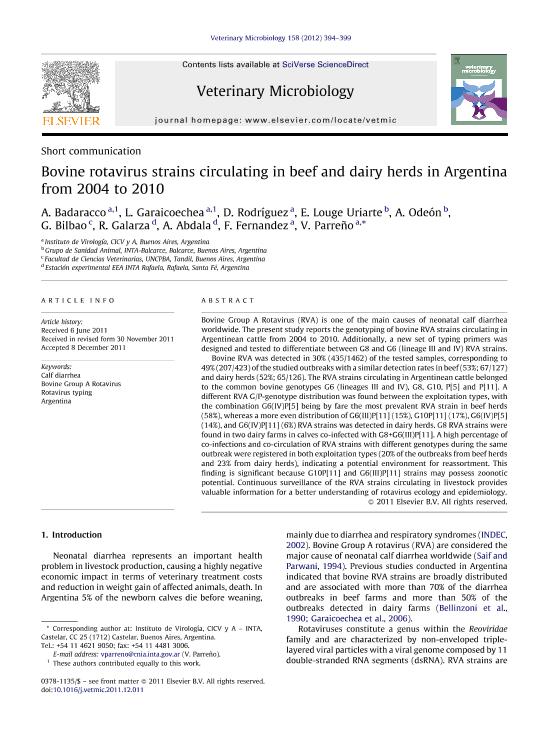Mostrar el registro sencillo del ítem
dc.contributor.author
Badaracco, Alejandra

dc.contributor.author
Garaicoechea, Lorena Laura

dc.contributor.author
Rodriguez, Daniela
dc.contributor.author
Louge Uriarte, Enrique Leopoldo

dc.contributor.author
Odeón, Anselmo Carlos

dc.contributor.author
Bilbao, Gladys Noemí

dc.contributor.author
Galarza, Roxana
dc.contributor.author
Abdala, Alejandro Ariel

dc.contributor.author
Fernández, Fernando

dc.contributor.author
Parreño, Gladys Viviana

dc.date.available
2023-05-11T11:05:04Z
dc.date.issued
2012-08
dc.identifier.citation
Badaracco, Alejandra; Garaicoechea, Lorena Laura; Rodriguez, Daniela; Louge Uriarte, Enrique Leopoldo; Odeón, Anselmo Carlos; et al.; Bovine rotavirus strains circulating in beef and dairy herds in Argentina from 2004 to 2010; Elsevier Science; Veterinary Microbiology; 158; 8-2012; 394-399
dc.identifier.issn
0378-1135
dc.identifier.uri
http://hdl.handle.net/11336/197106
dc.description.abstract
Bovine Group A Rotavirus (RVA) is one of the main causes of neonatal calf diarrhea worldwide. The present study reports the genotyping of bovine RVA strains circulating in Argentinean cattle from 2004 to 2010. Additionally, a new set of typing primers was designed and tested to differentiate between G8 and G6 (lineage III and IV) RVA strains. Bovine RVA was detected in 30% (435/1462) of the tested samples, corresponding to 49% (207/423) of the studied outbreaks with a similar detection rates in beef (53%; 67/127) and dairy herds (52%; 65/126). The RVA strains circulating in Argentinean cattle belonged to the common bovine genotypes G6 (lineages III and IV), G8, G10, P[5] and P[11]. A different RVA G/P-genotype distribution was found between the exploitation types, with the combination G6(IV)P[5] being by fare the most prevalent RVA strain in beef herds (58%), whereas a more even distribution of G6(III)P[11] (15%), G10P[11] (17%), G6(IV)P[5] (14%), and G6(IV)P[11] (6%) RVA strains was detected in dairy herds. G8 RVA strains were found in two dairy farms in calves co-infected with G8+G6(III)P[11]. A high percentage of co-infections and co-circulation of RVA strains with different genotypes during the same outbreak were registered in both exploitation types (20% of the outbreaks from beef herds and 23% from dairy herds), indicating a potential environment for reassortment. This finding is important to consider because G10P[11] and G6(III)P[11] strains might possess zoonotic potential. The continuous surveillance of the RVA strains circulating in livestock provides valuable information for a better understanding of rotavirus ecology and epidemiology.
dc.format
application/pdf
dc.language.iso
eng
dc.publisher
Elsevier Science

dc.rights
info:eu-repo/semantics/openAccess
dc.rights.uri
https://creativecommons.org/licenses/by-nc-sa/2.5/ar/
dc.subject
ROTAVIRUS
dc.subject
BOVINE
dc.subject
BEEF
dc.subject
DAIRY
dc.subject.classification
Ciencias Veterinarias

dc.subject.classification
Ciencias Veterinarias

dc.subject.classification
CIENCIAS AGRÍCOLAS

dc.title
Bovine rotavirus strains circulating in beef and dairy herds in Argentina from 2004 to 2010
dc.type
info:eu-repo/semantics/article
dc.type
info:ar-repo/semantics/artículo
dc.type
info:eu-repo/semantics/publishedVersion
dc.date.updated
2023-05-10T10:27:56Z
dc.journal.volume
158
dc.journal.pagination
394-399
dc.journal.pais
Países Bajos

dc.journal.ciudad
Amsterdam
dc.description.fil
Fil: Badaracco, Alejandra. Consejo Nacional de Investigaciones Científicas y Técnicas; Argentina. Instituto Nacional de Tecnología Agropecuaria. Centro de Investigación en Ciencias Veterinarias y Agronómicas. Instituto de Virología; Argentina
dc.description.fil
Fil: Garaicoechea, Lorena Laura. Instituto Nacional de Tecnología Agropecuaria. Centro de Investigación en Ciencias Veterinarias y Agronómicas. Instituto de Virología; Argentina. Consejo Nacional de Investigaciones Científicas y Técnicas; Argentina
dc.description.fil
Fil: Rodriguez, Daniela. Instituto Nacional de Tecnología Agropecuaria. Centro de Investigación en Ciencias Veterinarias y Agronómicas. Instituto de Virología; Argentina
dc.description.fil
Fil: Louge Uriarte, Enrique Leopoldo. Instituto Nacional de Tecnología Agropecuaria. Centro Regional Buenos Aires Sur. Estación Experimental Agropecuaria Balcarce; Argentina
dc.description.fil
Fil: Odeón, Anselmo Carlos. Instituto Nacional de Tecnología Agropecuaria. Centro Regional Buenos Aires Sur. Estación Experimental Agropecuaria Balcarce; Argentina
dc.description.fil
Fil: Bilbao, Gladys Noemí. Universidad Nacional del Centro de la Provincia de Buenos Aires. Facultad de Ciencias Veterinarias; Argentina
dc.description.fil
Fil: Galarza, Roxana. Instituto Nacional de Tecnología Agropecuaria. Centro Regional Santa Fe. Estación Experimental Agropecuaria Rafaela; Argentina
dc.description.fil
Fil: Abdala, Alejandro Ariel. Instituto Nacional de Tecnología Agropecuaria. Centro Regional Santa Fe. Estación Experimental Agropecuaria Rafaela; Argentina
dc.description.fil
Fil: Fernández, Fernando. Instituto Nacional de Tecnología Agropecuaria. Centro de Investigación en Ciencias Veterinarias y Agronómicas. Instituto de Virología; Argentina
dc.description.fil
Fil: Parreño, Gladys Viviana. Instituto Nacional de Tecnología Agropecuaria. Centro de Investigación en Ciencias Veterinarias y Agronómicas. Instituto de Virología; Argentina. Consejo Nacional de Investigaciones Científicas y Técnicas; Argentina
dc.journal.title
Veterinary Microbiology

dc.relation.alternativeid
info:eu-repo/semantics/altIdentifier/url/http://www.sciencedirect.com/science/article/pii/S0378113511006511
dc.relation.alternativeid
info:eu-repo/semantics/altIdentifier/doi/http://dx.doi.org/10.1016/j.vetmic.2011.12.011
Archivos asociados
